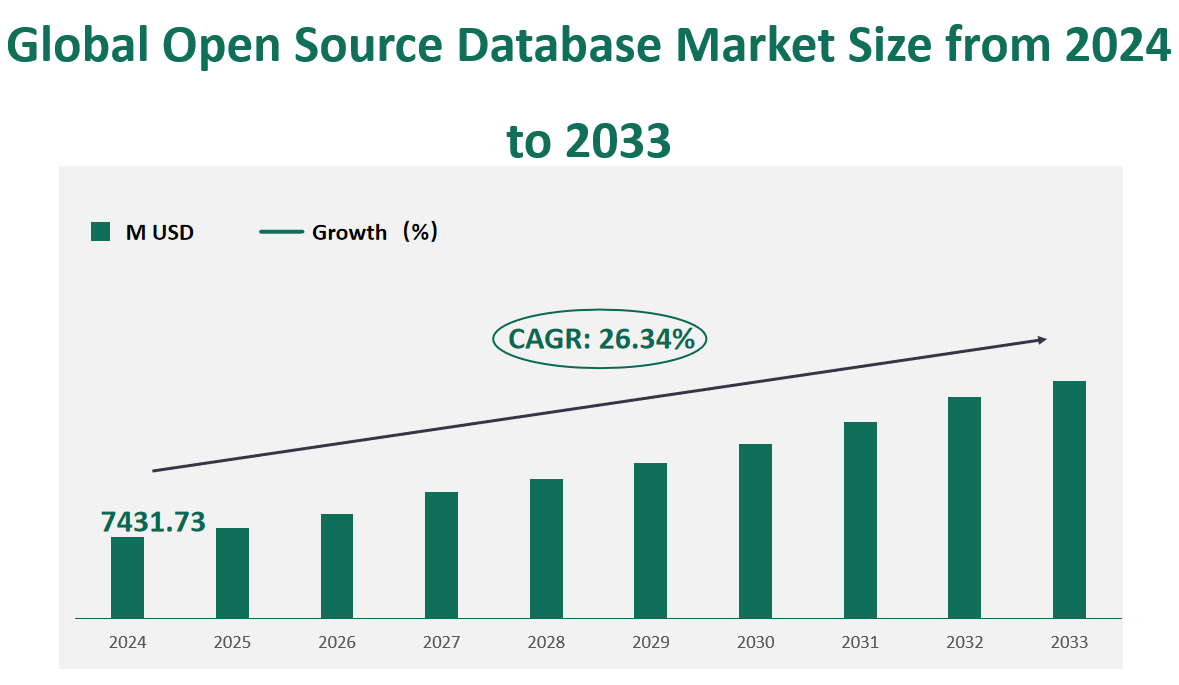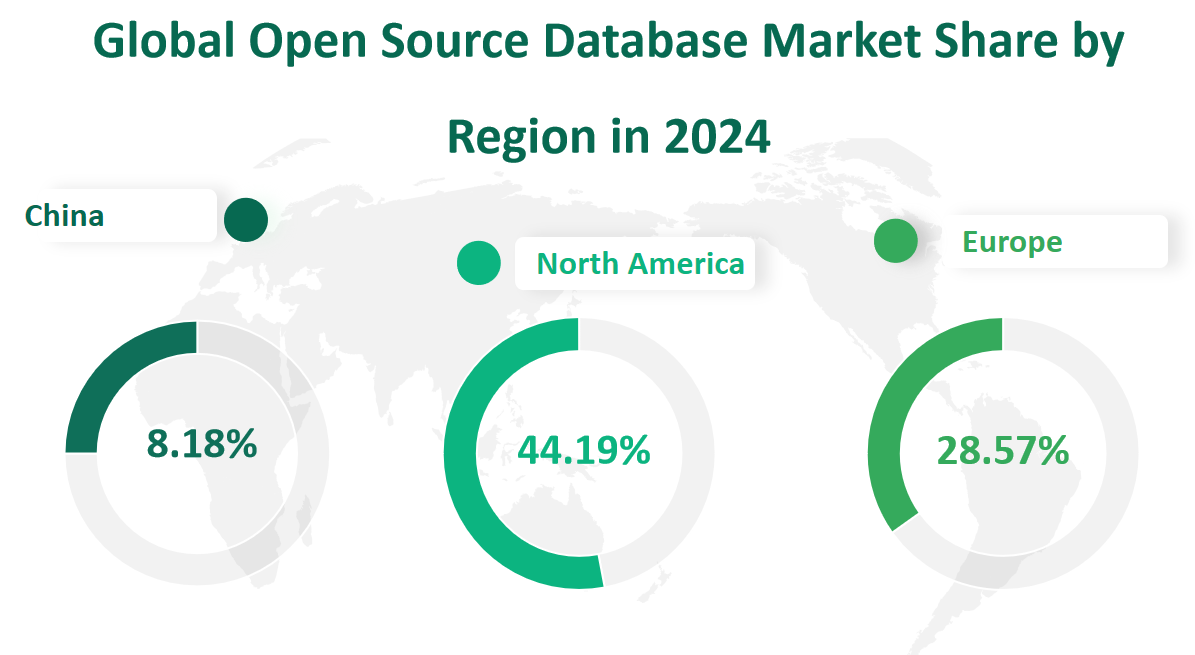1 Global Open Source Database Market Insight Analysis
The total value of the global Open Source Database market is expected to reach US$7431.73 million in 2024, with a CAGR of 26.34% from 2024 to 2033.
An Open Source Database is any database application with a codebase that is free to view, download, modify, distribute, and reuse. Open source licenses give developers the freedom to build new applications using existing database technologies.
Figure Global Open Source Database Market Size (M USD) and CAGR (2024-2033)

2 Open Source Database Market Growth Drivers and Restraints
The open source database market is experiencing rapid growth, propelled by several key drivers. One of the primary factors is the acceleration of digital transformation across industries. As companies increasingly adopt digital technologies to optimize operations and enhance customer experiences, the demand for efficient data management solutions rises, creating a substantial market opportunity for open source databases. The advent of cloud computing has been another significant catalyst, enabling databases to evolve towards cloud-native solutions that offer high scalability, performance, and elasticity, aligning with the growing preference for cloud-based services.
The exponential growth in global data volumes, driven by the internet of things (IoT), big data analytics, and the proliferation of digital services, has made data storage and management a critical concern for businesses. Open source databases, known for their low cost and ease of deployment, provide an attractive solution to manage this surge in data efficiently. Furthermore, the flexibility and customization options offered by open source databases have made them a popular choice for developers and businesses looking to tailor database solutions to specific needs.
Despite these drivers, the market faces certain limitations. Security concerns are a significant challenge, as open source databases can be more susceptible to vulnerabilities and attacks due to their public codebases. The potential instability of these databases, stemming from community-driven development and maintenance, can lead to reliability and performance issues. Market risks are also present, with well-established commercial database providers holding substantial market shares, making it difficult for smaller players to compete effectively. Additionally, the dependency of traditional industries and large enterprises on commercial databases poses a barrier to the widespread adoption of open source alternatives.
3 Technological Innovations and Mergers in the Open Source Database Market
Technological innovations have been a pivotal force in shaping the open source database market. Advances in distributed database systems have enabled high concurrency, availability, and scalability through techniques like data sharding and load balancing. The emergence of in-memory databases has significantly increased data processing speeds by storing data directly in memory, enhancing performance. NoSQL databases, which are particularly adept at handling unstructured data, have found broad applications in the IoT and social networking sectors, expanding the application scenarios for open source databases.
The development of new hardware technologies has also played a crucial role, providing fresh insights for database system design. Multi-processors, multi-cores, big memory, and solid-state drives (SSDs) have offered parallel processing capabilities, improved IOPS, and reduced latency for database systems. As the cost of these new hardware technologies decreases, leveraging them to enhance database performance and reduce costs becomes a key direction for the future development of open source databases.
In terms of corporate activities, mergers and acquisitions have led to market consolidation, creating larger entities with greater influence. These activities have not only expanded the product and service offerings of companies but also strengthened their market positions. For instance, the acquisition of Speedb by Redis to enhance real-time data processing capabilities and support for low-latency applications demonstrates the strategic moves companies are making to stay competitive. Such activities have also led to the integration of complementary technologies, enhancing the overall value proposition of open source database solutions in the market.
In summary, while technological advancements and strategic corporate activities have significantly contributed to the growth and development of the open source database market, they also present challenges that need to be addressed to ensure the market’s health and sustainability in the long term.
4 Global Open Source Database Market Size by Type
PostgreSQL, known for its extensibility and SQL compliance, is projected to reach a market value of $1036.42 million in 2024. This represents a significant share and highlights PostgreSQL’s growing popularity in the open source database ecosystem, particularly due to its robustness and ability to handle complex queries and large volumes of data.
MySQL, a widely used open source relational database management system, is expected to dominate the market with a value of $2282.77 million. MySQL’s versatility and widespread adoption across various applications, from small to large enterprises, contribute to its leading position in the market.
Cassandra, a distributed NoSQL database known for its high availability and scalability, is forecasted to generate $155.25 million. Cassandra’s market presence is particularly strong in applications that require handling large amounts of data across multiple nodes and data centers.
Couchbase, a NoSQL document-oriented database, is projected to have a market value of $222.27 million. Couchbase’s ability to provide interactive applications with fast data access and flexible data modeling has made it a preferred choice in certain sectors.
In terms of market share, PostgreSQL is anticipated to hold 13.95% of the total market, MySQL 30.72%, Cassandra 2.09%, Couchbase 2.99%, and the Others category 50.26%. These figures underscore the fragmented nature of the open source database market, where a variety of database types coexist to serve different market segments and application needs.
Table Global Open Source Database Market Size and Share by Type in 2024
Type | Market Size (M USD) 2024 | Market Share 2024 |
|---|---|---|
PostgreSQL | 1036.42 | 13.95% |
MySQL | 2282.77 | 30.72% |
Cassandra | 155.25 | 2.09% |
Couchbase | 222.27 | 2.99% |
Others | 3735.04 | 50.26% |
5 Global Open Source Database Market Size by Application
In 2024, the market is anticipated to be led by the Internet sector, with a projected revenue of $1936.10 million, accounting for a 26.05% share of the total market. The Internet industry’s reliance on open source databases for web-based applications, cloud services, and big data management is a key driver for this segment’s dominance.
The Government sector is expected to generate $1036.11 million, holding a 13.94% share. Open source databases play a crucial role in government digital transformation initiatives, particularly in areas such as data analytics, public service delivery, and cybersecurity.
The Financial sector is projected to reach $1892.71 million, capturing a 25.47% share. This segment’s growth is attributed to the increasing adoption of open source databases in banking, insurance, and financial services for tasks such as fraud detection, risk management, and transaction processing.
The Research and Education sector is estimated to contribute $283.12 million, with a 3.81% share. Open source databases are instrumental in research data management, academic collaboration, and educational analytics.
Table Global Open Source Database Market Size and Share by Application in 2024
Application | Market Size (M USD) 2024 | Market Share 2024 |
|---|---|---|
Internet | 1936.10 | 26.05% |
Government | 1036.11 | 13.94% |
Financial | 1892.71 | 25.47% |
Research & Education | 283.12 | 3.81% |
Other | 2283.70 | 30.73% |
6 Global Open Source Database Market Size by Region
Geographically, the global open source database market is distributed across various regions, each with distinct market dynamics. In 2024, North America is anticipated to lead with a market value of $3283.91 million, representing a 44.19% share. The region’s strong technology infrastructure, high adoption of cloud services, and significant investment in digital transformation initiatives contribute to its dominance.
Europe follows with a projected market value of $2123.62 million, accounting for a 28.57% share. The region’s mature IT sector and progressive policies supporting open source technology adoption are key factors driving the market.
China is expected to contribute $607.80 million, with an 8.18% share. The country’s rapid digitalization, growing tech industry, and increasing focus on data-driven decision-making are boosting the market for open source databases.
The Middle East and Africa are projected to reach $223.85 million, representing a 3.01% share. While the region has a smaller market share, it is witnessing growth due to the adoption of digital technologies in sectors such as oil and gas, finance, and government services.
India is anticipated to generate $159.91 million, holding a 2.15% share. The country’s burgeoning IT industry, start-up ecosystem, and increasing focus on data analytics are contributing to the market’s expansion.
South America, with a market value of $178.40 billion, represents a 2.40% share. The region’s market is driven by countries like Brazil and Argentina, which are adopting open source databases in their digital transformation efforts.
Figure Global Open Source Database Market Size (M USD) by Region in 2024

7 Global Open Source Database Market Analysis by Major Players
7.1 Oracle MySQL
Company Introduction and Business Overview:
Oracle MySQL, established in 1995 and part of the Oracle Corporation since 2008, is a leading open source relational database management system (RDBMS). It is known for its high performance, reliability, and ease of use, making it a popular choice for web-based applications.
Oracle MySQL operates worldwide, providing a robust database solution for a variety of applications. It is particularly favored for its ability to handle large volumes of data and concurrent requests, which is crucial for high-traffic websites and cloud-based applications.
Products:
Oracle MySQL offers a range of products including the MySQL Enterprise Edition for business-critical applications and Embedded MySQL Enterprise Edition for independent software vendors (ISVs), original equipment manufacturers (OEMs), and value-added resellers (VARs). They also provide cloud services like Heatwave for GenAI and ML.
Market Performance in 2024:
In 2024, Oracle MySQL is projected to achieve a revenue of $2282.77 million with a gross margin of $1683.08 million.
7.2 MongoDB
Company Introduction and Business Overview:
MongoDB, founded in 2007, is a developer and provider of commercial support for the open-source database, MongoDB. It has grown to become a significant player in the database industry, known for its flexible and scalable document-oriented database.
MongoDB Inc operates primarily in North America, Europe, and Asia Pacific, offering a management platform for automating, monitoring, and backing up deployments. Their flagship product, MongoDB Atlas, is a cloud-hosted database service that simplifies the process of establishing, operating, and scaling MongoDB deployments.
Products:
MongoDB’s product portfolio includes MongoDB Atlas, which provides a fully managed cloud database service, and various developer tools such as Compass, Ops Manager, and BI connectors. They also offer community versions of MongoDB for installation on various platforms.
Market Performance in 2024:
In 2024, MongoDB is expected to generate a revenue of $2227.49 million, with a gross margin of $1643.66 million.
7.3 EDB
Company Introduction and Business Overview:
EDB, established in 2004, is a leading provider of enterprise-class PostgreSQL-based products and services. It is recognized for driving innovation with software and services that enable businesses to harness the full power of Postgres.
EDB operates worldwide, offering a suite of products that enhance the capabilities of PostgreSQL, the world’s most advanced open source database. Their solutions are designed to meet the needs of large enterprises and government organizations.
Products:
EDB’s product line includes enterprise-grade Postgres solutions with enhanced features such as data encryption, compliance readiness, and boosted query performance. They also provide 24/7 expert support from the creators of PostgreSQL.
Market Performance in 2024:
In 2024, EDB is projected to achieve a revenue of $693.12 million and a gross margin of $500.09 million.





